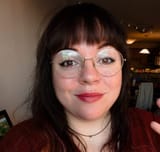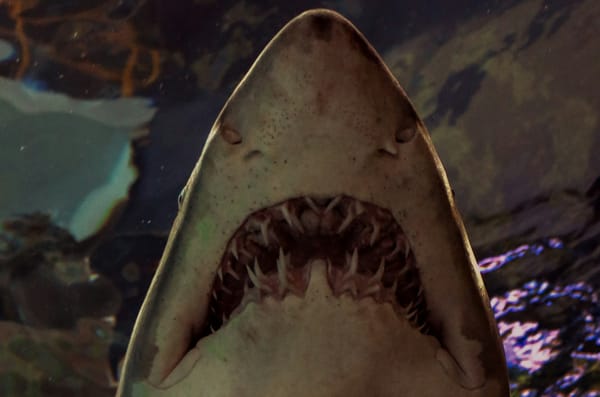The Frog Pond #1: Everything becomes crab
or, uncertain waters and why everybody wants to be a crab.

Welcome to my first newsletter! So happy to have you here at the frog pond, a quiet space away from the hustle and bustle to take a moment to breathe, enjoy a weird fact, and think about frogs.
Settle in amid the reeds
You turned left instead of right on your otherwise familiar forest path, and now stand at the edge of a small pond lined with cattails and reeds. The sound of water lapping, frogs croaking, and distant birdsong quiets as you sit down and take a moment to yourself.
Today’s pond session is new, refreshing, and full of possibilities.
Mist-erious knowledge
A mist floats above the waterline. It reaches out a tendril to you. You hear whispers within its hidden form—the excited titters of the incorporeal nerd of the natural world desperate to share a cool fact.
You reach out, and when your fingers touch the cool mist, you are filled with mist-erious knowledge.
Did you know that evolution just loves crabs?
There are at least 5 types of pseudo-crabs that have evolved completely independently from crabs (and each other), but share the familiar crabby features we all know and love. From the humble hermit crab to the king crab, these species are a result of carcinisation1, a biological phenomenon where crab-like features keep cropping up in non-crab species throughout the course of their evolution.
Did you also know some crab-like crustaceans un-crab?
Decarcinisation2 is the process of losing those crab-like features over the course of evolution. The fact that there is a word for this completely tickles my fancy! Not everyone’s suited to the crab life, alas.
Viva la crab revolution!
The Cretaceous Crab Revolution3, that is. From 146 to 66 Million years ago, nearly 80% of crabs originated during this event. While there are some more ancient crabs, most crabs spread throughout waterways during this time to disperse all over the world!
Oh, to be a newly evolved crab, among my many evolutionary cousins!
Turns out a lot of species follow evolutionary fads!
In broader terms, convergent evolution4 (repeated similar traits evolving from animals that are not connected by lineage) can be found all over the history of flora and fauna!
From the horned snouts of ceratopsian dinosaurs (like triceratops) to the prickly protrusions of the skin (like hedgehogs), these trends in evolution, while not linked together, offer an insight into the elements of animals that keep working across time, environment, and species.
This brings me to wonder…
In your storytelling, what could the concepts of carcinisation, decarcinisation, and/or convergent evolution look like?
A word from a passing frog
Hi! I hope you like this little half-fiction, half-non-fiction, all-nonsense newsletter!
This is my section to update how I’m fairing. Like reading one of those migration trackers they put on geese and whales.
Writing
I’m currently querying my adult gothic horror novel, AKA Lighthouse Book. I started querying in mid-October, so I’m now a month and a half in, somehow! It’s a lot of “hurry up and wait”, as many of you know! I’m feeling positive, impatient, and thankful to finally be at this stage of the writing/publishing process.
Otherwise, I’m in the pre-writing and outline phase of my next project, an adult thriller with horror and romance elements, AKA Bachelor Hell Book. It’s a mystery set on a romance reality TV show on a private island, about a young woman’s search for her missing sister as well as a dozen other women who have disappeared over the course of the show’s 60-year run.
I’m having a lot of fun and taking my time as the weather grows colder and my query inbox hopefully fills with news!
Reading
I just finished THE GUEST LIST by Lucy Foley - a murder mystery set at a wedding on a remote island. I loved how Foley wrote so many compelling, complex characters! It was great research into the mystery/suspense/thriller genres as I prepare to draft, and gave me an appreciation for the depths that Foley is able to incorporate into her work!
I’m just starting BABEL by R. F. Kuang as my big December read. Only about a half hour in, but I already love the voice and I can’t wait to see how Kuang takes on the big themes of language, colonialism, and academia!
A prompt on a lilypad
You return from the mist to the edge of the pond, only to find a lilypad floating where before lay only still water.
On the lilypad is a note. You reach out, and it reads:
Consider the ways you use nature (animals, plants, weather, environment, etc.) in your stories.
What do you feel drawn to include in your writing?
What does nature symbolize within the stories you tell?
How can nature shape a character, a place, or a plot?
You stand up from the pond’s edge. Dust off the dirt from your clothes. There are responsibilities and joys to get on with. Food to make, friends to see, words to write. The world keeps moving, even if the frog pond stays quiet, strange, and weirdly wonderful.
But maybe you’ll turn left again, the next time you go walking.
Footnotes
1 https://brill.com/view/journals/ctoz/67/2/article-p79_1.xml
2 https://onlinelibrary.wiley.com/doi/10.1002/bies.202100020
3 https://www.ncbi.nlm.nih.gov/pmc/articles/PMC6482010/
4 https://en.wikipedia.org/wiki/List_of_examples_of_convergent_evolution





